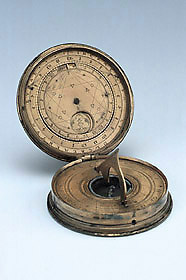
 |
| Catalogue |
 |
 Astronomical Compendium The outer face of the cover carries a volvelle for converting common hours into planetary (unequal) or Italian hours, and vice versa. Around the edge of the cover is a scale of hours I to XII, I to XII, each divided to 1/2 and 1/4. Inside this scale of common hours are two sets of lines, one for 'HORAE PLANETARVM DIEI ET NOCTIS' 1 to 12 and the other for 'HORAE ITALICI' 10 to 24. A double line separates the two sets. A rotating index engraved with a zodiac scale (using the standard symbols of the signs) enables the conversions to be made. The latitude for which the volvelle was constructed can be inferred from the time of sunrise when the sun is at the first point of Cancer: the time of about 4:20 corresponds to approximately 44?. At the centre of the rotating index is a circular disc engraved with an astrological table showing which planets rule the hours of the day. The disc is divided into seven sectors with a sequence of planetary symbols in the centre, arranged in the order of the days of the week: Sun, Moon, Mars, Mercury, Jupiter, Venus, Saturn. Surrounding this sequence is a spiral of numbers 1 to 12, set out so that 1 and 8 fall on the sign of the Sun. This volvelle moves against a fixed circular scale, also with seven divisions and marked 'D. SOLIS', 'D. VENER.', and similarly through Mercury, Moon, Saturn Jupiter and Mars. The reverse of the cover carries a lunar volvelle. Around a fixed outer scale of hours 1 to 12, 1 to 12, divided to 1/4, is the title 'INCRMENTVM [sic] ET DECREMENTVM LVNAE'. The edge of the volvelle is cut away to reveal a scale for the age of the moon 1 to 29[1/2] and there is a circular aperture to display the phases of the moon, with a face at full moon. The volvelle's scale of hours is divided and numbered to match the fixed scale of hours, and surrounds a diagram of aspects inscribed with an equilateral triangle, square and hexagon, together with symbols for conjunction and opposition, as well as trine, quadrature and sextile. The next plate carries an inclining dial whose folding gnomon is sprung to the vertical by a (steel?) ring on the underside of the plate. The hour lines run 4 to 12 to 8 and in the night time space is the signature 'C S'. The folding latitude scale used to elevate the dial plate is now missing. It would have been housed in the box compartment when the compendium was closed and held in place by a notch in the dial plate while in use. A folded scrap of paper kept in the box compartment records the collector Lewis Evans' reconstruction of this missing latitude scale, with the suggestion that the arc scale would have covered latitudes in the range 43 to 60?. The dial plate has a circular hole through which the compass can be seen. The compass plate has direction cross marked 'SE', 'OR', 'ME' and 'OC' for the four cardinal points. The compass bowl has an external diameter of 22 mm and is fixed in the base of the box compartment, surrounded by a wind rose with pointers to the Italian names of the eight winds. A further eight smaller pointers subdivide these eight principal directions. Stephen Johnston |



